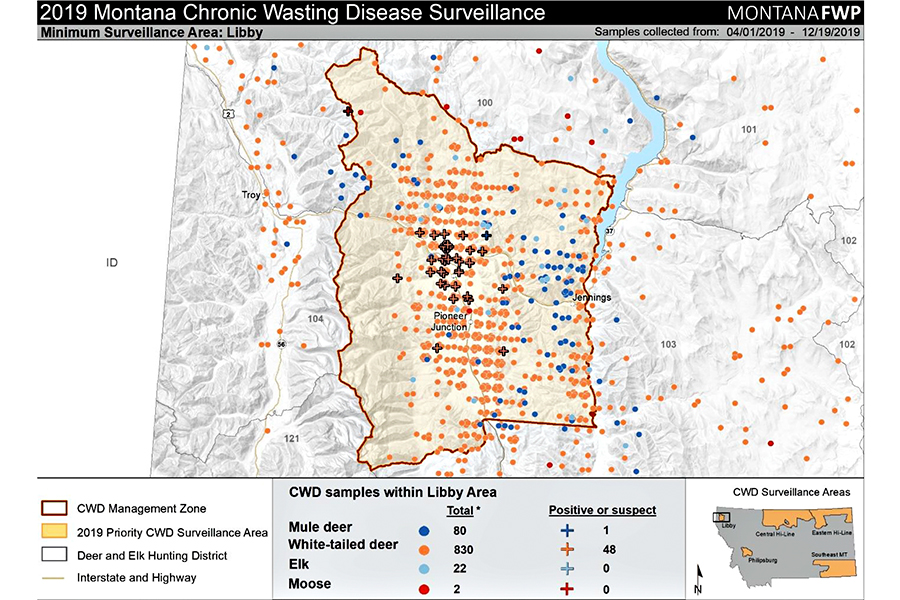Montana Fish, Wildlife and Parks is once again relying on hunters to be citizen-scientists during the fall harvest season to help collect data on chronic wasting disease (CWD). The department uses voluntarily submitted samples from hunters in order to inform management strategies for hunting districts where the disease is prevalent.
FWP states on its website that “hunting is the primary tool for monitoring and managing the spread of CWD,” and that “concerns over CWD shouldn’t stop you from enjoying the hunting season.”
CWD is a neurological disease that affects deer, elk and moose. Infected animals may carry the disease for years without showing signs of illness, according to FWP, but it can lead to weight loss, lack of coordination and physical debilitation. If unmanaged, CWD has been known to vastly decrease local cervid populations.
In 2019, FWP significantly increased its surveillance testing for CWD, which was first detected in wild populations in Montana in 2017, and in captive game farms in 1999. Utilizing voluntary sampling by hunters, FWP wildlife officials tested 7,025 animals during the 2019 season, which ran from April 1 2019 until Jan. 29, 2020. The department focused on several high-priority sampling areas, including the Hi-Line, the Philipsburg area, southeastern Montana and the Libby area.
Of the samples, 144 tested positive for the fatal disease, including 53 mule deer, 88 white-tailed deer, two moose and one elk. These were Montana’s first detections in moose and wild elk.
A white-tailed doe in the Libby area marked the first time the disease had been detected west of the Continental Divide in Montana. In response, FWP set up a priority surveillance area surrounding Libby and detected 60 positive cases in the area, almost exclusively in white-tailed deer.
Within the town of Libby itself, CWD was prevalent in 13.3% of white-tailed deer, one of the highest concentrations in the state. Wildlife researchers believe the high positivity rate is likely due to the lack of harvesting within city limits, which allows deer to age and interact at a higher level, spreading the disease.
A report released on the study indicated that the disease has likely been present in the area for a decade, and has been “aggravated by high white-tailed deer densities sharing localized food sources, like birdfeeders, fruit trees and the town dump.”
For the 2020 season, FWP is not setting up management zones or restricting transportation of harvested animals, but will still be conducting surveillance in priority areas.
Hunters are asked to voluntarily submit harvested deer, elk or moose for officials to sample. CWD check stations and sampling locations are set up around the state. In the northwest Region 1, hunters can take animals to the FWP regional office in Kalispell, or visit sampling stations in Libby, Olney or Thompson Falls. Hunters looking to get animals sampled are encouraged to call ahead to ensure the offices are staffed, as many FWP officials are working remotely.
In order to further limit the spread of CWD, the use of scents and lures using cervid-derived glandular scents is prohibited in Montana. Hunters should also report any sick-looking deer, elk or moose to their local FWP offices as soon as possible.
CWD is caused by a mis-folded prion protein in cervid populations, and infected animals are contagious for about two years before dying. Since the disease was initially discovered in 1967, it has been found in 26 states, three provinces and four other countries around the world.
There is no known instance of CWD transmission to humans, and no evidence that humans can develop neurological issues related to the disease. Even so, FWP advises that hunters wear gloves when processing animals. Hunters should skin and gut their kills quickly, cool them quickly and cook any harvested meet well before consumption.
The Centers for Disease Control and Prevention (CDC) recommends that all animals harvested in an area where CWD is known to be present be tested. The CDC also advises against eating the meat of any animal that tests positive. FWP requires that carcasses are properly disposed of, which means all parts must be bagged and disposed of in a landfill or left at the kill site.
